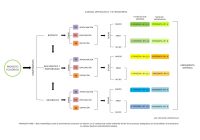Esta investigación parte del proceso iniciado en el 2010 con la tesina de la UPC , enfocándose en este caso, de forma mas concreta, en una aproximación sistémica a los ejes hidrográficos en el contexto urbano, pretendiendo llegar a una referencia metodológica cualitativa y cuantitativa que permitiera servir de base para generar estrategias más integrales para el desarrollo urbano desde la visión ecológica.
Fue realizada como tesis del master propio en Energías Renovables: Arquitectura y Urbanismo, La Ciudad Sostenible, de la Universidad Internacional de Andalucia – Huelva, España en el 2011. Acompañada por el Dr. Jordi Morató, Director de la Catedra UNESCO de Sostenibilidad de la UPC.
ABSTRACT
Stopping the loss of biodiversity that traditional urban models suppose in relation with natural systems and enhance its regeneration, becomes in one of the main challenges to face in the present, ensuring the sustainability and permanence of the urban areas over time and their adaptation to the climate change.
The ecological connectivity it’s presented as one of the main subjects that guarantee the stability of the natural systems in the quest of urban biodiversity. Within this, the hydrographic systems (which enable the most efficient ecological exchange in the territory, and the stabilization of its environmental conditions), deserve their ecological recuperation and rehabilitation for enabling the biodiversity regeneration and becoming their main components or axes in potentials ecological corridors within cities.
Based on the above, this research is inscribed in the field of the ecological connectivity in the urban context linked to the hydrographical systems (water mains) and their main components and infrastructures. It is taken as case of study the city of Medellin-Colombia; a city with a urban model highly determined for its hydrographical system and its own disturbance.
It is presented a methodological basis from a basic indicator system that would allow an hydro morphological approach to the system components (water axes) under the ecological connectivity criteria in the urban context, identifying quantitatively its characteristics (ecological conditions, status and potential ecological connectivity), as a basis for future planning and monitoring interventions (founded on more sustainable environmental rehabilitation strategies) for the current hydrographic system in the urban context. This indicator system could be a complement for the Planes Integrales de Ordenamiento y Manejo de las Microcuencas (PIOMS) (watersheds management plans) that have been currently formulated and implemented in Medellin and other city models with similar conditions.



